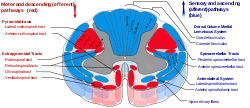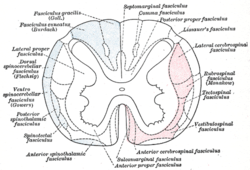Anterolateral system
| Spinothalamic tract | |
|---|---|

Spinothalamic tracts are grouped, in blue at bottom right.
|
|

Diagram of the principal fasciculi of the spinal cord. (Anterior and posterior spinothalamic fasciculus is labeled at bottom left.)
|
|
| Details | |
| Identifiers | |
| Latin | Tractus spinothalamicus |
| NeuroNames | ancil-114 |
| TA | A14.1.04.138 |
| FMA | 72644 |
|
Anatomical terms of neuroanatomy
[]
|
|
The spinothalamic tract (also known as anterolateral system or the ventrolateral system) is a sensory pathway from the skin to the thalamus. From the ventral posterolateral nucleus in the thalamus, sensory information is relayed upward to the somatosensory cortex of the postcentral gyrus.
The spinothalamic tract consists of two adjacent pathways: anterior and lateral. The anterior spinothalamic tract carries information about crude touch. The lateral spinothalamic tract conveys pain and temperature.
In the spinal cord, the spinothalamic tract has somatotopic organization. This is the segmental organization of its cervical, thoracic, lumbar, and sacral components, which is arranged from most medial to most lateral respectively.
The pathway decussates at the level of the spinal cord, rather than in the brainstem like the posterior column-medial lemniscus pathway and lateral corticospinal tract.
There are two main parts of the spinothalamic tract (STT):
The spinothalamic tract, like the dorsal column-medial lemniscus tract, uses three neurons to convey sensory information from the periphery to conscious level at the cerebral cortex.
Pseudounipolar neurons in the dorsal root ganglion have axons that lead from the skin into the dorsal spinal cord where they ascend or descend one or two vertebral levels via Lissauer's tract and then synapse with secondary neurons in either the substantia gelatinosa of Rolando or the nucleus proprius. These secondary neurons are called tract cells.
...
Wikipedia
